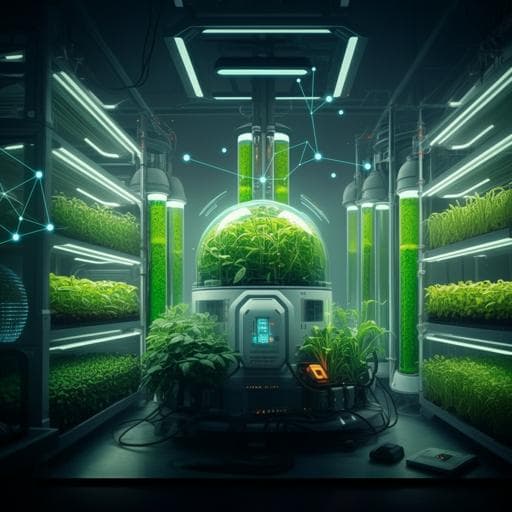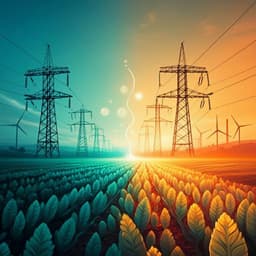
Food Science and Technology
Transition to cellular agriculture reduces agriculture land use and greenhouse gas emissions but increases demand for critical materials
M. E. Wali, S. R. Golroudbary, et al.
This groundbreaking study by Mohammad El Wali, Saeed Rahimpour Golroudbary, Andrzej Kraslawski, and Hanna L. Tuomisto explores the potential of cellular agriculture to revolutionize food security. Our findings reveal that by 2050, transitioning to cultured meat and microbial proteins could drastically reduce greenhouse gas emissions, phosphorus demand, and land use, all while highlighting the challenges of critical material demands. Discover how this shift could shape our environmental future!
~3 min • Beginner • English
Introduction
The study addresses how far cellular agriculture—specifically microbial protein (MP) and cell-cultured recombinant proteins (RP)—powered by low-carbon energy can replace livestock meat, dairy, and eggs by 2050 while reducing environmental burdens and staying within critical material supply limits. Motivated by livestock’s large climate footprint (about 20% of anthropogenic GHG emissions) and the projected 40% increase in livestock protein demand by 2050, the authors investigate whether cellular agriculture can deliver comparable protein with lower greenhouse gases, land, and phosphorus use. Because cellular agriculture is energy-intensive, the work explicitly considers the role of wind and solar PV to decarbonize production and examines the implications for critical materials required by these energy technologies. The core research questions are: to what extent can green-energy-powered cellular foods meet global protein demand without exceeding primary production capacities of critical materials, and what are the impacts on GHG emissions, agricultural land, and phosphorus consumption.
Literature Review
Prior research indicates substantial environmental benefits from replacing animal products with alternatives, including microbial proteins and cultured meat. Studies have shown cellular agriculture can reduce global warming and resource use compared to conventional livestock. Humpenöder et al. reported potential to replace up to 80% of ruminant meat with microbial proteins. However, the energy and material implications are significant: wind power relies on REE-based permanent magnets (Nd, Pr, Dy, Tb) and boron; solar PV requires Si, and in some technologies Te, In, Ga, and Ge; and bioprocess equipment commonly uses stainless steel (Cr, Ni). Criticality assessments by USGS and EU highlight supply risks for these materials amid expanding green technologies. The literature underscores the need to integrate food, energy, and materials perspectives to assess sustainability of cellular agriculture at scale.
Methodology
The authors developed a global system dynamics (SD) model coupled with life-cycle assessment (LCA) to simulate a 2020–2050 transition from livestock to cellular agriculture. The model integrates food production (crops, livestock, cellular proteins), energy supply (wind and solar PV), agricultural land use (arable, pasture), greenhouse gas emissions, phosphorus flows, and critical material requirements. Cellular products include microbial protein from hydrogen-oxidizing bacteria and cell-cultured recombinant proteins produced with Trichoderma reesei, parameterized using inventory and impact data from Järviö et al. The transition follows an S-curve adoption pattern with scenarios from 0% to 100% replacement in 10% increments (Scn0–Scn10). Replacement is protein-based: MP substitutes meats (beef, pork, lamb, poultry), while RP substitutes eggs, dairy (milk, cheese), and meats according to protein content. The system boundary is cradle-to-gate: for crops and livestock up to farmgate; for cellular products including fermentation/cultivation, downstream processing, cleaning, and required energy and material inputs; for energy, the cradle-to-gate material and energy requirements of wind and PV are included. Energy demand distinguishes direct electricity for unit operations and indirect energy embodied in inputs and energy supply infrastructure. Green energy capacity projections to 2050 use Carrara et al.’s Low-, Middle-, and High-demand scenarios (LDS, MDS, HDS), considering subtechnology shares, plant lifetimes, and material intensities. GHG intensities for livestock and crops use global means from Poore and Nemecek; cellular protein emission factors come from Järviö et al.; recycling-related emissions are computed from energy use and source-specific emission factors. Land use is allocated to feed (arable) and grazing (pasture) for livestock; cellular agriculture land is attributed to maize-derived glucose for RP; MP requires no cropland for carbon (uses CO2 and H2). Phosphorus flows include primary production (phosphate rock), fertilizer manufacture, crop uptake, livestock feed use, losses (mining/processing, agricultural runoff, waste), and recycling from manure and wastewater. Critical material demand is derived from technology-specific material intensity coefficients for wind and PV (including structural materials Al, Zn, Mn, Cr, Ni and functional materials REEs, B, Si, Te, In, Ga, Ge) and stainless steel grades (304/316) used in dairy, wastewater treatment, and cellular bioprocessing. The model computes installed capacities and annual additions for wind/PV and stainless steel requirements using lifetimes and capacity factors. Country-level analyses allocate potential replacement based on projected national wind and PV capacities and national shares of global livestock protein. Primary production capacities for critical materials are compiled from USGS and other authoritative sources. Sensitivity analyses increase cellular agriculture electricity use by 20% and glucose inputs by 20% to test robustness. Model validation compares outputs (P production, fertilizers, land use, food-system GHG) to historical data, achieving at least 95% compatibility.
Key Findings
- Energy demand: A full replacement (Scn10) increases global food-system energy demand by 69% with wind (to ~14.6 PWh) and by 83% with solar PV (to ~15.8 PWh) by 2050; 52–56% of this demand is from MP and RP production. Solar PV entails ~1.3× higher indirect energy per kWh than wind.
- Deployment feasibility: With national 2050 capacities, up to 72% of livestock protein can be replaced by cellular products (37% wind; 35% solar), concentrated in Europe, North America, and Northeast Asia. With global pooling of capacities, a complete transition by 2050 is achievable using at most 33% of global green energy capacity (≈2120 GW wind or 2500 GW PV under lowest energy projection). Using a single source, the transition would require at most ~1530 GW wind or ~1265 GW PV.
- GHG emissions: Despite higher electricity demand, annual food-system GHG emissions fall by 52% under Scn10 by 2050 to ~7.4 Gt CO2-eq (about 48% of current agricultural emissions). Cumulatively, up to 132 Gt CO2-eq are avoided by 2050 versus no replacement.
- Land use: Agricultural land use declines by 83% by 2050, freeing ~9.6 million km². Pasture use largely disappears; remaining arable land is driven by crop production for RP glucose (maize), contributing up to ~6% of arable land in 2050 under Scn10. Global maize demand drops from ~1.2 billion tonnes (2020) to ~883 million tonnes (2050) due to elimination of livestock feed demand.
- Phosphorus: Primary phosphate rock production declines by up to 53% by 2050 under full replacement. Total crop production decreases by ~40%; phosphorus losses (runoff and livestock waste) drop by ~51%.
- Infrastructure and materials: By 2050, cumulative installed capacity for food-system energy reaches ~1530 GW wind and ~1265 GW PV in Scn10. Annual PV additions reach ~50.5 GW; wind ~68.5 GW (vs ~1–2.6 GW with no replacement). Stainless steel demand for food-system facilities decreases by ~16% under Scn10, with wastewater treatment dominating steel use.
- Critical materials demand (percent of current primary production, indicative): REEs for wind (Nd, Pr, Dy, Tb) up to ~9–17%; structural materials for wind (Al ~0.1%, Mn ~0.17%, Zn ~1.9%); PV-related materials: Te up to ~34%, Ge ~19%, Ga/In/Si ~1.6–21% depending on element. In the solar-powered pathway, higher stainless steel intensity increases Ni and Cr demand (to ~23% and ~2% of their primary productions), whereas in the wind pathway, Ni and Cr demand declines by ~13% due to dairy elimination.
- Capacity constraints: Most critical materials remain within primary production capacity by 2050 under full transition when powered by wind or solar, except tellurium. Te production capacity (~673 t) constrains solar-powered transitions to ~60% replacement unless technology shifts, recovery, or recycling improve.
- Sensitivity: +20% electricity consumption increases wind/PV-related material demand by ~19–20% and Ni/Cr by ~11%. Under this higher electricity case, Te capacity constrains transitions to ~50% by 2050. +20% glucose raises GHG by ~1.3%, land by ~1.2%, and primary P use by ~2.6%.
Discussion
The results demonstrate that cellular agriculture can significantly decarbonize and dematerialize the global food system when powered by renewables, even after accounting for increased electricity needs and associated material inputs. The analysis answers the central question by showing that, globally, wind- or solar-powered cellular proteins can replace livestock proteins with large reductions in GHG emissions, land occupation, and phosphorus use, while staying within primary production capacities for most critical materials. Te emerges as a potential bottleneck due to PV reliance, highlighting the value of technology diversification (greater use of wind, c-Si dominance with minimized Te-dependent PV shares), material efficiency, and improved recovery and recycling. Combining wind and solar can smooth regional capacity constraints and optimize material demand profiles, reducing pressure on any single critical material. The study also contextualizes temporal climate dynamics, noting that while CO2 increases with greater electricity use, methane decreases sharply with livestock decline; full climate evaluation over longer horizons is warranted. Nutritional equivalency in protein does not guarantee equivalency in micronutrients, implying dietary adjustments and formulation of cellular products are necessary. Economic, supply-chain, and recycling uncertainties in critical materials markets, as well as the exclusion of livestock by-products and post-farmgate processing, temper the generalizability of exact magnitudes but not the direction of benefits.
Conclusion
A global transition from livestock to cellular agriculture, powered by renewable energy, is technically feasible by 2050 and confers major environmental benefits: roughly halving annual food-system GHG emissions, reducing agricultural land use by over four-fifths, and cutting primary phosphorus requirements by more than half. Under pooled global capacities, full replacement requires under one-third of projected 2050 green electricity capacity; under national capacities, about 72% replacement is still achievable. Critical material demands remain within primary production capacities in most cases, with tellurium as a notable constraint for solar-heavy pathways. Strategic combinations of wind and solar, advances in PV technology, material substitution, efficiency, and recycling can alleviate constraints. Future research should: integrate livestock by-products and downstream processing; extend climate analysis beyond 2050 to capture CO2–CH4 dynamics; incorporate land-type detail for restoration potential; evaluate nutritional adequacy and product formulation; and explicitly model price dynamics, supply risks, recycling, and scale-up uncertainties in cellular agriculture.
Limitations
- System boundary is cradle-to-gate (up to farmgate for livestock/crops), excluding post-farmgate processing, packaging, distribution, and consumer phases.
- Livestock by-products (e.g., hides, fats, offal, pharmaceuticals) are not modeled; their replacement pathways and impacts are unassessed.
- Cellular products considered are powders; additional processing to consumer-ready analogs is not included.
- Use of global mean LCA values masks regional variability and high impact ranges (notably for beef), contributing to uncertainty.
- The 2020–2050 horizon is short for fully assessing long-lived CO2 vs short-lived CH4 climate dynamics.
- Material supply assumptions rely on current primary production capacities and do not endogenize future mining, co-product recovery (e.g., Te from Cu), substitution, or recycling scale-up.
- Price volatility and supply–demand feedbacks for critical materials and energy technologies are not explicitly modeled; capacity projections may be sensitive to market dynamics.
- Land categories (e.g., marginal grazing land) are not differentiated, limiting inference on restoration and biodiversity outcomes.
- Industrial-scale cellular agriculture process inventories remain uncertain; scale-up may alter energy and material intensities.
- National capacity analyses assume priorities and access to domestic capacities; trade, policy, and social acceptance factors are not modeled.
Related Publications
Explore these studies to deepen your understanding of the subject.







